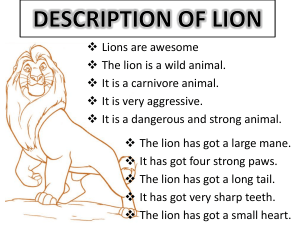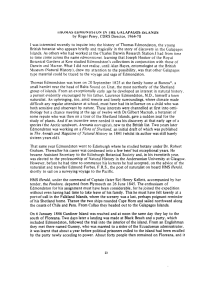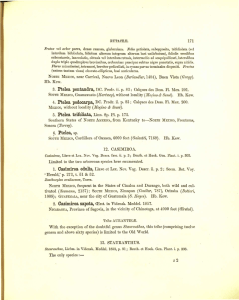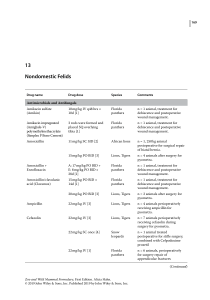Extralimital Distribution of Galapagos - Instituto de Ecología
Anuncio
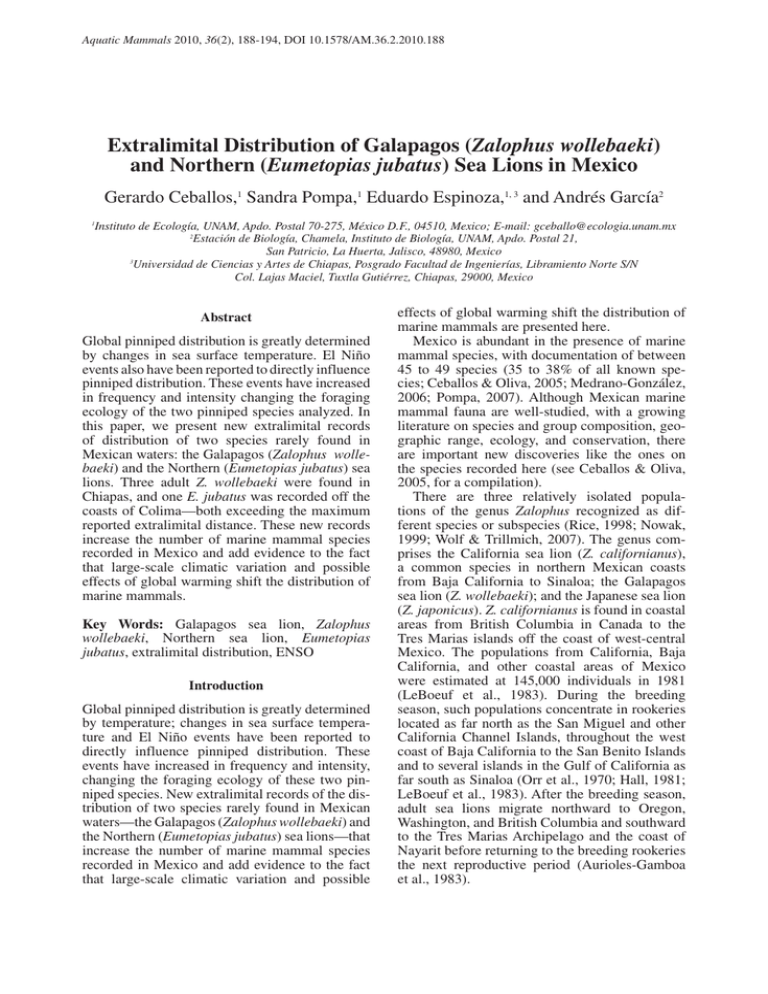
Aquatic Mammals 2010, 36(2), 188-194, DOI 10.1578/AM.36.2.2010.188 Extralimital Distribution of Galapagos (Zalophus wollebaeki) and Northern (Eumetopias jubatus) Sea Lions in Mexico Gerardo Ceballos,1 Sandra Pompa,1 Eduardo Espinoza,1, 3 and Andrés García2 Instituto de Ecología, UNAM, Apdo. Postal 70‑275, México D.F., 04510, Mexico; E‑mail: gceballo@ecologia.unam.mx 2 Estación de Biología, Chamela, Instituto de Biología, UNAM, Apdo. Postal 21, San Patricio, La Huerta, Jalisco, 48980, Mexico 3 Universidad de Ciencias y Artes de Chiapas, Posgrado Facultad de Ingenierías, Libramiento Norte S/N Col. Lajas Maciel, Tuxtla Gutiérrez, Chiapas, 29000, Mexico 1 Abstract Global pinniped distribution is greatly determined by changes in sea surface temperature. El Niño events also have been reported to directly influence pinniped distribution. These events have increased in frequency and intensity changing the foraging ecology of the two pinniped species analyzed. In this paper, we present new extralimital records of distribution of two species rarely found in Mexican waters: the Galapagos (Zalophus wolle‑ baeki) and the Northern (Eumetopias jubatus) sea lions. Three adult Z. wollebaeki were found in Chiapas, and one E. jubatus was recorded off the coasts of Colima—both exceeding the maximum reported extralimital distance. These new records increase the number of marine mammal species recorded in Mexico and add evidence to the fact that large-scale climatic variation and possible effects of global warming shift the distribution of marine mammals. Key Words: Galapagos sea lion, Zalophus wollebaeki, Northern sea lion, Eumetopias jubatus, extralimital distribution, ENSO Introduction Global pinniped distribution is greatly determined by temperature; changes in sea surface temperature and El Niño events have been reported to directly influence pinniped distribution. These events have increased in frequency and intensity, changing the foraging ecology of these two pinniped species. New extralimital records of the distribution of two species rarely found in Mexican waters—the Galapagos (Zalophus wollebaeki) and the Northern (Eumetopias jubatus) sea lions—that increase the number of marine mammal species recorded in Mexico and add evidence to the fact that large-scale climatic variation and possible effects of global warming shift the distribution of marine mammals are presented here. Mexico is abundant in the presence of marine mammal species, with documentation of between 45 to 49 species (35 to 38% of all known species; Ceballos & Oliva, 2005; Medrano-González, 2006; Pompa, 2007). Although Mexican marine mammal fauna are well-studied, with a growing literature on species and group composition, geographic range, ecology, and conservation, there are important new discoveries like the ones on the species recorded here (see Ceballos & Oliva, 2005, for a compilation). There are three relatively isolated populations of the genus Zalophus recognized as different species or subspecies (Rice, 1998; Nowak, 1999; Wolf & Trillmich, 2007). The genus comprises the California sea lion (Z. californianus), a common species in northern Mexican coasts from Baja California to Sinaloa; the Galapagos sea lion (Z. wollebaeki); and the Japanese sea lion (Z. japonicus). Z. californianus is found in coastal areas from British Columbia in Canada to the Tres Marias islands off the coast of west-central Mexico. The populations from California, Baja California, and other coastal areas of Mexico were estimated at 145,000 individuals in 1981 (LeBoeuf et al., 1983). During the breeding season, such populations concentrate in rookeries located as far north as the San Miguel and other California Channel Islands, throughout the west coast of Baja California to the San Benito Islands and to several islands in the Gulf of California as far south as Sinaloa (Orr et al., 1970; Hall, 1981; LeBoeuf et al., 1983). After the breeding season, adult sea lions migrate northward to Oregon, Washington, and British Columbia and southward to the Tres Marias Archipelago and the coast of Nayarit before returning to the breeding rookeries the next reproductive period (Aurioles-Gamboa et al., 1983). The Galapagos sea lions are exclusively known from the Galapagos Islands and are found throughout the Galapagos Archipelago on all the major islands and on many smaller islands, as well as occasionally in coastal Ecuador and Colombia (Rice, 1998). A colony was established in 1986 at Isla de la Plata, just offshore from mainland Ecuador, but the site is not regularly used. Vagrants can be seen from the Ecuadorian coast north to Isla Gorgona in Colombia. There is also a record of a vagrant from Isla del Coco approximately 500 km southwest of Costa Rica (International Union for Conservation of Nature [IUCN], 2009). Due to its small range, small and fluctuating population size, and a suggested decline of 50% over the last 30 y, the Galapagos sea lion is classified as endangered (IUCN, 2009). Z. japonicus, which is probably extinct, was known from coastal areas in Japan and Korea (Mate, 1982). Recent genetic data support the classification as a separate species (Wolf et al., 2007). These sea lion populations have apparently been isolated since the Pleistocene epoch (Aurioles-Gamboa et al., 2000). The other pinniped involved in this work is the Northern sea lion, found from central California to the north along the west coast of North America to the Aleutian Islands across the Bering Sea to the Bering Strait. From there, they range to Kamchatka Peninsula, Sea of Okhotsk, Kuril Islands, northern Japan, and possibly to both Koreas. Vagrants have been recorded in China and at Herschel Island in the Beaufort Sea (Rice, 1998). Methods Our work is based on fortuitous observations of sea lions in the coast of Colima and Chiapas. In August 1997, three adult sea lions, two females and one male, later identified as Galapagos sea lions, were found on a beach in the Chiapas coast. The two males were dead; the female was in critical condition, lying still on the beach, very weak, and very thin (bones, especially the ribcage, were noticeable). She made no attempt to escape during her transportation to the Tuxtla Gutierrez City Zoo (ZooMAT, Miguel Alvarez del Toro, founder) in Chiapas, and she died during the journey. A necropsy showed that the animal likely died from complications associated with starvation, and she had no stomach contents. Regarding the Northern sea lion, an individual was registered from July through November 2008 off the coast of Colima, Mexico. An employee of a gas plant informed us of an animal resting over a buoy. Results and Discussion Galapagos Sea Lion Our specimen showed characteristics that are diagnostic of Z. wollebaeki such as narrow mandible insertion condyles, well-developed mastoid crests (not shown in Z. californianus females), smaller tympanic bulla, six post-canine teeth, and double-root molars. Skull morphology indicated that the female was around 4 y old (Figure 1). At the same age, Z. wollebaeki is generally smaller than Z. californianus. The skull characteristics and a comparison with six Z. californianus females from the Gulf of California confirmed that this individual belonged to Z. wollebaeki (Table 1). The cluster analysis showed that our specimen belongs to a single-tree branch by itself and did not cluster with any of the other female specimens of Z. californianus (Figure 2). The sea lions were found within the Biosphere Reserve “La Encrucijada” at 15º 41' 15" N and 92º 01' 23" W, 25 km south of Acapetahua, Chiapas. This location is found approximately 1,800 km northeast of the Galapagos Islands (Figure 3). There is no documented evidence of movements of sea lions between the Galapagos and Mexican populations. Galapagos sea lions are sexually dimorphic, with males growing larger than females and having a suite of several secondary Table 1. Comparative cranial measures of six female skulls of Z. californianus from the osteological collection at the Biological Institute at the Universidad Nacional Autónoma de Mexico (UNAM) and our specimen Catalog # Sample 35178 35177 3863 4144 1118 15337 LoTo CoCo AnCr ArCi AnIt AnRo AnFp Estimated age 186 231 225 211 210 189 151 92.3 100.1 100.3 91.8 79.0 77.4 71.2 91.1 95.3 95.8 101.2 94.7 94.9 89.7 113.3 124.8 122.3 113.9 97.6 93.9 84.8 22.3 24.1 26.4 34.0 32.2 35.6 37.9 33.1 38.0 45.2 43.3 37.4 35.8 34.8 27.5 30.8 34.6 30.2 27.5 26.9 26.5 4 years 8 years 8 years 7 years Juvenile 2 years Juvenile 2 years Juvenile 1 year? LoTo = greatest length of skull, CoCo = greatest breadth of skull, AnCr = breadth of braincase, ArCi = zygomatic breadth, Anlt = interorbital constriction, AnRo = face breadth, and AnFp = pterigoidea breadth 190 Ceballos et al. A) B) A) B) C) Figure 1. Dorsal (A), ventral (B), and lateral (C) views of the skull of one of the three stranded Galapagos sea lions (Zalophus wollebaeki), showing typical characteristics of the species such as narrow mandible insertion condyles, well-developed C)Z. californianus females), smaller tympanic bulla, six post-canine teeth, and double-root molars mastoid crests (not shown in (Photos: Ana Isabel Bieler) Figure 1. Dorsal (A), ventral (B), and lateral (C) views of the skull of one of the sexual characteristics. The degree of sexual dimorphism appears to be less than in California three stranded Galapagos sea lions wollebaeki), typical lions, although fewshowing weights andone measurements specimen Figure 1. Dorsal (A), ventral (B), and(Zalophus lateralsea (C) views of the skull of of the 4144 are available for adults to confirm this suggestion. 1118 The longest distance recorded as traveled by indicharacteristics of the species a narrow mandible insertion condyles, well 15337 three stranded Galapagos seasuch lionsas(Zalophus wollebaeki), showing typical viduals of Z. californianus is more than 1,700 km 35178 from Baja California and California to Oregon 35177 and British Columbia (Hancock, 1970).tympanic There developed mastoid crests (not shown in Z. californianus females), smaller 3863 characteristics of the species such as a narrow mandible insertion condyles, well are occasional, extralimital records of individuals wandering south of what is considered their normal bulla, six post-canine teeth(not andshown double-root molars (Photos: Ana Isabel Bieler). geographic rangefemales), in Mexico. For example, there developed mastoid crests in Z. californianus smaller tympanic are recent records in Acapulco (State of Guerrero: Gallo-Reynoso & Ortega-Ojeda, 1986; Gallobulla, six post-canine teeth and double-root Reynoso molars&(Photos: Ana Isabel Solórzano-Velasco, 1991),Bieler). Huatulco (Oaxaca: García & Ortega-del Valle, 2002), and Puerto Madero (Chiapas: Gallo-Reynoso & Solórzano-Velasco, 1991) in the southern coast of the Mexican Pacific. What explanation can be given for the presence of the three Galapagos sea lion specimens along the coast of Mexico? In 1997, the El Niño pheFigure 2. Statistical cluster analysis of cranial measures nomenon raised sea surface temperatures (SST) of six Z. californianus and our specimen; the tree shows to 5° C comparative to 1998 (Figure 4). SST at three clades: one with three adult specimens, another Figure 2. Statistical cluster analysis of cranial measures of sevenwith Z. californianus Galapagos Islands in February 1997 was already three juveniles, and our specimen. The distance and separaand our specimen. Thethat treeour shows threeisclades, onetowith three adult specimens, 1° C higher, by April it was 2° C, 3° C in June, and tion show specimen different Z. californianus around 4.5° C by August (National Oceanic and and is comparable to Z. wollebaeki from the Galapagos other with three juvenile and our specimen. The distance and separation show that Atmospheric Administration [NOAA], 2009). This Islands. our specimen is different to Z. californianus, and is comparable to Z. wollebaeki from the Galapagos Islands. Figure 3. Extralimital distributions of the Galapagos sea lion (Z. wollebaeki) in the coast of Chiapas, with registered distribution in straight lines and locality of sighting (square); and of the Northern sea lion (Eumetopias jubatus) in the coast of Colima, with registered distribution in inclined lines and the locality of sighting (dot). Figure 4. Extralimital distributions of the Galapagos sea lion (Z. wollebaeki) in the rise in SST killed 48% of the Galapagos sea lion Northern Sea Lion We identified the specimen from Colima as a population and their food resources (Trillmich coast of Chiapas, lines and locality of on sighting Northern sea lion (Eumetopias jubatus) the basis & Dellinger, 1991).registered Based on thedistribution evidence pre- in straight of its external morphology, which clearly shows sented here, we believe that the rise in SST trigthe face, rostrum, bodyofshape typical of this gered the Galapagos lion to search prey (square); and of thesea Northern sea for lion (E. jubatus) in the and coast Colima, species. The animal was approximately 3 m long, beyond its known distribution boundaries, reachand its weight was around 800 to 1,000 kg (Figure ing as far north as Mexico. Aside from our record, registered inclined and the locality of took sighting 5). He continually sunbaths(dot). on the buoys used specimensdistribution were recordedinoff the coastlines of Baja to anchor boats. It did not seem to be disturbed by California (Aurioles-Gamboa et al., 1993). This the presence of fishermen or the boats arriving to climatological phenomenon can facilitate disperdisembark. The sea lion disappeared in November. sal and promote gene flow between these two popThe animal was found off the coasts of Colima, ulations—Z. californianus and Z. wollebaeki— Mexico, between Tepalcates Canal and Campos which may have diverged in the Pleistocene epoch Village (UTM 13, 2101350.76 and 576251.36) in (1.8 million years ago) (Wolf et al., 2007). This Manzanillo (Figure 3). This locality is 3,000 km has important biogeographical, evolutionary, and south from its typical geographic range (IUCN, conservation implications. 192 Ceballos et al. Figure 4. Sea surface temperature (SST) during the 1997 El Niño phenomenon (data from NOAA, 2009, analyzed at the University of California–Irvine School of Biological Sciences and modified for this publication); see the Galapagos Islands (box) and where our specimen Z. wollebaeki was found (arrow). Shading indicates where the mean (zero on the scale) exceeds one standard error (SE). Figure 5. Northern sea lion (E. jubatus) resting in a buoy off the coasts of Manzanillo, Colima Figure 6. Composite of ENSO SST anomalies as a function of time and longitude along the equator for (a) El Niño and (b) La Niña for the period 1980 to 2008; contour interval is 0.25° C for all plots. Shading indicates the most robust features of the composites where the mean exceeds one SE (modified from McPhaden & Zhang, 2009). 2009), representing the most southern distribution record of the species. This exceptional record could probably be explained by the 2006 to 2008 ENSO (El Niño/Southern Oscillation) cycle, and a considerable (ca. -2° C) drop in SST in the 2008 La Niña year (Figure 6; McPhaden & Zhang, 2009) Changes in SST and ENSO events directly influence pinniped distribution. In recent years, these events have become both more pronounced and frequent, thus changing the foraging ecology of these two pinniped species. Climatic changes affect prey distribution and abundance and, consequently, predator foraging ranges, explaining the unusual sightings mentioned in this manuscript (Würsig, 2002; Intergovernmental Panel for Climate Change [IPCC], 2007). The new records presented in this paper increase the number of marine mammal species documented along the coast of Mexico. They represent an excellent example of the effects of large-scale climatic variation and indicate some possible effects of global warming in the movements of marine mammals (McGravin & Simmonds, 1996; Learmoth et al., 2006; Simmonds & Isaac, 2007). Acknowledgments We would like to thank the personnel at the Biosphere Reserve “La Encrucijada,” Luis Sigler, Carlos Guichard, and Epigmenio Cruz, and Ivan Lira from the Natural History Institute of Chiapas for the information given on the conditions under which individuals were found. Specimens of Z. californianus were kindly loaned to us by the National Mammal Collection of the Instituto de Biología de la Universidad Nacional Autónoma de Mexico. Zeta Gas del Pacífico, S.A. de C.V. kindly provided the pictures of the Northern sea lion on the Colima coast. Heliot Zarza from the Ecology Institute at the Universidad Nacional Autónoma de Mexico provided us with the map for Figure 3. Literature Cited Aurioles-Gamboa, D., Le Boeuf, B. J., & Findley, L. T. (1993). Registros de pinnípedos poco comúnes para el Golfo de California [Sightings of uncommon pinnipeds for the Gulf of California]. Revista de la Investigacion Cientifica de la Universidad Autonoma de Baja California Sur, 1(No. Especial de la SOMEMMA), 13-19. Aurioles-Gamboa, D., Flacón, S. C., Contreras, I., & Barnes, L. G. (2000). Patrón latitudinal en caracteres dentarios del lobo marino de California en Norteamérica [Latitudinal pattern in dental characters on the California sea lion in North America (Zalophus californianus californianus)]. XXV Reunión Internacional para el Estudio de los Mamíferos Marinos, La Paz, Mexico. Aurioles-Gamboa, D., Sinsel, F., Fox, C., Alvarado, E., & Maravilla, O. (1983). Winter migration of subadult male California sea lions (Zalophus californianus) in the southern part of Baja California. Journal of Mammalogy, 64, 513-518. Ceballos, G., & Oliva, G. (2005). Los mamíferos silvestres de México. México D.F.: CONABIO – Fondo de Cultura Económica. 988 pp. Gallo-Reynoso, J. P., & Ortega-Ojeda, A. (1986). First record of Zalophus californianus in Acapulco, México. Marine Mammal Science, 2, 158. Gallo-Reynoso, J. P., & Solórzano-Velasco, J. L. (1991). Two new sightings of California sea lions on the southern coast of Mexico. Marine Mammal Science, 7(1), 96. 194 Ceballos et al. García, R. M., & Ortega-del Valle, D. (2002, May). Avistamiento de un lobo marino de California en Bahía Riscalillo, Huatulco, Oaxaca, México [Sighting of California sea lion in Bahia Riscalillo, Huatulco, Oaxaca, Mexico]. XXVII Reunión Internacional para el Estudio de los Mamíferos Marinos, Veracruz, Mexico. Hall, R. (1981). The mammals of North America. New York: John Wiley & Sons. Hancock, D. (1970). California sea lion as a regular visitant off the British Columbia coast. Journal of Mammalogy, 51(3), 614. Intergovernmental Panel for Climate Change (IPCC). (2007). Climate change 2007: Synthesis report. Retrieved 17 May 2010 from www.ipcc.ch/pdf/assessment-report/ ar4/syr/ar4_syr.pdf. International Union for Conservation of Nature (IUCN). (2009). 2009 IUCN red list of threatened species. Retrieved 17 May 2010 from www.iucnredlist.org. Learmoth, J. A., Macleod, C. D., Santos, M. B., Pierce, G. J., Crick, H. Q. P., & Robinson, R. A. (2006). Potential effects of climate change on marine mammals. In R. N. Gibson, R. J. A. Atkinson, & J. D. Gordon (Eds.), Oceanography and marine biology: An annual review 44 (pp. 431-464). Oxford, UK: Taylor & Francis. LeBoeuf, B. J., Aurioles-Gamboa, D., Condit, R., Fox, C., Gisiner, R., Romero, R., et al. (1983). Size and distribution of the California sea lion population in México. Proceedings of the California Academy of Sciences, 43(7), 77-85. Mate, B. R. (1982). History and present status of the California sea lion, Zalophus californianus. In G. Clark, J. Goodman, & G. A. Soave (Eds.), Mammals in the seas. Vol. IV: Small cetaceans, seals, sirenians and otters (pp. 303-309). Rome: Food and Agriculture Organization of the United Nations. McGravin, M., & Simmonds, M. P. (1996). Whales and climate change. In M. P. Simmonds & J. D. Hutchinson (Eds.), The conservation of whales and dolphins: Science and practice (pp. 321-332). Chichester, UK: John Wiley & Sons. McPhaden, M. J., & Zhang, X. (2009). Asymmetry in zonal phase propagation of ENSO sea surface temperature anomalies. Geophysical Research Letters, 36, L13703. doi:10.1029/2009GL038774 Medrano-González, L. (2006). Hacia una dinámica de la mastofauna marina Mexicana: Análisis de composición funcional y de algunas estructuras genéticas poblacionales [Towards a dynamic view of the Mexican marine mammal fauna: Functional composition anaylysis and genetic structure of some populations]. In E. VázquezDomínguez & D. J. Hafner (Eds.), Genética y mamíferos Mexicanos: Presente y futuro. New Mexico Museum of Natural History and Science Bulletin, 32, 9-19. National Oceanic and Atmospheric Administration (NOAA). (2009). PSD map room climate products: Sea surface temperature. Retrieved 17 May 2010 from www. esrl.noaa.gov/psd/map/clim/sst.shtml. Nowak, R. M. (1999). Walker’s mammals of the world, Vol. II (6th ed.). Baltimore: The Johns Hopkins University Press. Orr, T. R., Schonewald, J., & Kenyon, K. W. (1970). The California sea lion: Skull growth and a comparison of two populations. Proceedings of the California Academy of Sciences, 38(11), 381-394. Pompa, S. (2007). Distribución y abundancia de los géne‑ ros Kogia y Steno en la Bahía de Banderas y aguas ady‑ acentes [Distribution and abundance of the genus Kogia and Steno in Bahía de Banderas and adjacent waters]. Tesis de Maestría, Facultad de Ciencias, Universidad Nacional Autónoma de México. Rice, D. W. (1998). Marine mammals of the world: Systematics and distribution (Special Publication No. 4). Lawrence, KS: Society of Marine Mammalogy. 231 pp. Simmonds, M. P., & Isaac, S. J. (2007). The impacts of climate change on marine mammals: Early signs of significant problems. Oryx, 41(1), 19-26. Trillmich, F., & Dellinger, T. (1991). The effects of El Niño on Galapagos pinnipeds. Ecological Studies – Pinnipeds and El Niño 1991, 88, 66-74. University of California–Irvine School of Biological Sciences. (1997). The 1997-98 El Niño/Southern Oscillation (ENSO 97-98): One of the most severe ENSO events in history? (Comp. D. Duffy & P. J. Bryant). Retrieved 17 May 2010 from http://darwin.bio. uci.edu/~sustain/ENSO.html. Wolf, J. B. W., & Trillmich, F. (2007). Fine-scale site fidelity in a breeding colony of the Galapagos sea lion (Zalophus californianus wollebaeki): A prerequisite for social networking? Oecologia, 152, 553-567. Wolf, J. B. W., Tauta, D., & Trillmich, F. (2007). Galápagos and Californian sea lions are separate species: Genetic analysis of the genus Zalophus and its implications for conservation management. Frontiers in Zoology, 4, 20. doi:10.1186/1742-9994-4-20 Würsig, B. (2002). Ecology, overview. In W. F. Perrin, B. Würsig, & J. G. M. Thewissen (Eds.), The encyclo‑ pedia of marine mammals (pp. 367-370). San Diego: Academic Press.
